|
On September 15, 1931, a research bureau was created in the Soviet Union to study various aspects of rocketry:
GIRD, Group for the Study of Jet Propulsion
(Gruppa Izucheniya Reaktivhogo Dvizheniya).
At this time, there were a number of amateur groups and lone researchers, but GIRD was the world's first large professional rocketry program.
The group was organized into four brigades and ten projects to study rocket engines and winged and unwinged missiles. Sergey Korolev, the future leader of the Soviet space program, was the over-all chief of GIRD, as well as a brigade leader and the chairman of its technical council. It was an early demonstration of his impressive skill as a project manager.
The 1st Brigade
Fridrikh Arturovich Tsander headed the 1st brigade. This was Tsander's research team, transferred to GIRD from The Institute of Aircraft Engine Construction (IAM). Tsander had begun to think about rocket-powered interplanetary flight, as early as 1907. He was one of the founding members of the Society for the Study of Interplanetary Communication in 1924, and a primary founder of GIRD.
Tsander began work on the OR-1 experimental engine in 1929, while still at IAM. This became GIRD project 01. It would be considered a hybrid today, rather than a pure liquid-fuel engine, since it ran on compressed air and gasoline. Tsander used it to investigate energetic fuels including powdered metals mixed with gasoline. The chamber was cooled regeneratively by air entering at the nozzle end. The nozzle was further cooled by water circulating through a coil.
Project 02, the OR-2 engine, was designed for Korolev's RP-1 rocket-powered glider. It burned gaseous oxygen and gasoline, producing a thrust of 50 kgf (kilogram-force). Its nozzle was made from heat-resistant graphite. Note the oxygen gas inlet near the nozzle, which as in the OR-1 was used to regeneratively cool the combustion chamber. The engine was later modified to burn alcohol, which generated less heat than gasoline, and its thrust was increased to 80 kgf.
After cooling the engine walls, the compressed oxygen entered the top end of the chamber in a swirling pattern. Fuel was injected through an atomizer at the center, to create efficient mixing and combustion.
The project 10 engine was designed for the GIRD-X rocket and first bench tested in March of 1933. Burning LOX and gasoline, it producing a thrust of 70 kgf. This was also one of the first engines to be regeneratively cooled. The coolant was the liquid oxygen, which entered in the tubes near the base and flowed around the inner wall of the combustion chamber before entering it. Problems with burn-through during testing prompted the switch to 78% alcohol, a less energetic fuel.
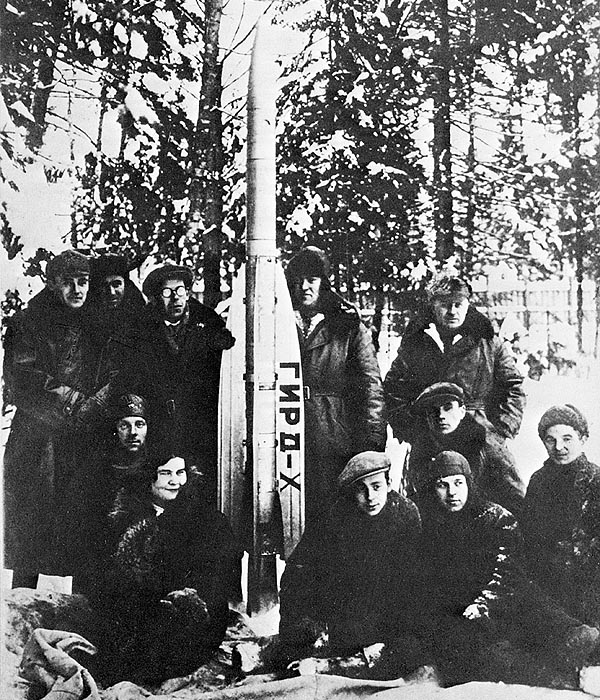
The GIRD-X Rocket (1933)
On March 28, 1933, Tsander died unexpectedly from an illness.
One of Tsander's engineers, Leonid Konstinovich Korneev, became the new brigade leader. He is seen standing just to the right of the GRID-X rocket, in the photo above.
The project 10 rocket was launched, on November 25 1933. It flew to a height of 80 meters before engine failure. This was the first true liquid-fuel rocket to fly in the Soviet Union, although it was not particularly successful. (Note: "X" is the Roman numeral 10, not the Russian letter "Kh").
The first brigade contained six engineers and six designers:
F.A. Tsander
L.K. Korneev
A.I. Polyarny
|
|
A.I. Gryaznov
L.S. Dushkin
A.V. Salikov
|
|
N.M. Vever
L.N. Kolbasina
E.K. Moshkin
|
|
A.I. Podipaev
S.S. Smirnov
A.V. Lavrov
|
The 2nd Brigade
Mikhail Klavdievich Tikhonravov headed GIRD's 2nd brigade, which worked on four projects.
Tikhonravov, an Engineer, would later oversee the design of the Sputnik satellite and the first Luna probes.
Project 03 was the development of a pump-fed engine called RDA-1, to be fueled by LOX and gasoline. This project was not completed.

Project 05 Design
Project 05 was actually the third rocket designed by Tikhonravov's brigade (after 07 and 09). In a joint effort with the Gas Dynamics Lab (GDL) in Leningrad, the 05 was to use the ORM-50 engine developed by Valentin Glushko. That was a nitric acid/kerosene engine with a nozzle cooled regeneratively by the flow of acid.
First tested in November of 1933, the ORM-50 predated the regeneratively cooled engines tested by Eugene Sänger in Austria.
Often credited for the invention, Sänger's first regeneratively cooled engine (SR-5) was not tested until May 1934.
Early German rockets immersed the rocket engine within the fuel or LOX tanks, a design that resulted in a number of explosions (although Reidel did experiment with regenerative cooling in 1933). Goddard favored fuel-curtain cooling. Tsander's engines (projects 01, 02 and 10) are the earliest examples of regeneratively cooled rocket engines, dating from as early as 1929-1933.
The 05 rocket contained four long tanks, enclosed in body with a four-lobed cross section.
It was never completed, but a few years later its design formed the basis of the Aviavnito rocket. Aviavnito was powered by Leonid Dushkin's 12-K engine, fueled by LOX and 96% alcohol. First launched in 1936, the rocket achieved an altitude of 3000 meters the next year.
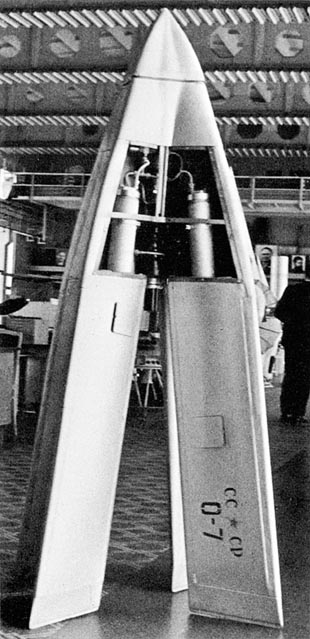
The GIRD-07 Rocket
|
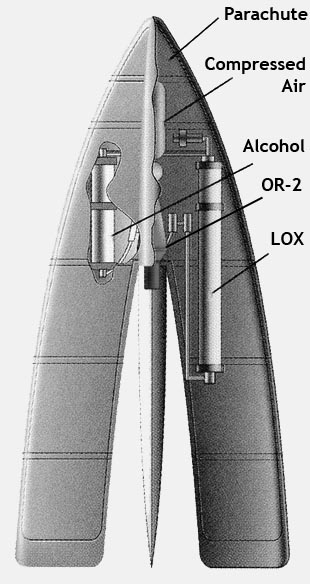
Schematic
|
Project 07 was the first rocket that Tikhonravov's brigade worked on. Its purpose was to test a LOX/kerosene propulsion system, and its unusual design included fuel tanks in the oversized fins.
It was powered by Tsander's project 02 (OR-2) engine.
The rocket was not flown until November 1934, using alcohol as fuel.
 Efremov's Hybrid Engine
Efremov's Hybrid Engine
|
 Testing the 09 Engine
Testing the 09 Engine
|
Project 09 produced the first rocket to actually be flown by GIRD. In an unusual experiment by engineer Nikolai Efremov, the engine was designed to run on LOX and a semisolid fuel made by dissolving rosin in gasoline.
Liquid oxygen entered the combustion chamber from a bronze nozzle at the top, and the grease-like fuel was forced in through holes around the side of the chamber's inner wall.
In this manner, the burning fuel would shield the brass engine from extreme heat.
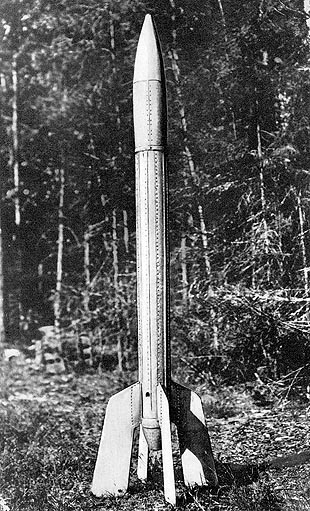 The GIRD-09 Rocket
The GIRD-09 Rocket
|
 Preparing for Launch (1933)
Preparing for Launch (1933)
|
The 09 rocket was launched from a vertical track.
The first of these was launched on August 17, 1933, and reached an altitude of 400 meters.
In the photo above, Korolev can be seen at the far left, and Pobedonostsev on the far right.
Nikolai Efremov is filling the liquid-oxygen tank.
This is sometimes considered the first Soviet liquid-fuel rocket launch, but others claim it is
actually a hybrid-fuel rocket.
On November 3, a second was launched, but its engine exploded at 100 meters. In January of 1934,
A GIRD-09 rocket reached an altitude of 1500 meters.
The second brigade consisted of six engineers and six designers
M.K. Tikhonravov
N.I. Efremov
Ya.A. Golyshev
|
|
V.S. Zuev
Y.A. Fedul
F.L. Yakaitis
|
|
V.N. Galkovsky
Z.I. Kruglova
O.K. Parovina
|
|
N.I. Shulgina
V.A. Andreev
E.I. Snegireva
|
The 3rd Brigade
Yuri Aleksandrovich Pobedonostsev was chief of GIRD's third brigade, which was given two projects (04 and 08).
One of these projects was the development of a supersonic wind tunnel, which developed a flow of Mach-3.2.
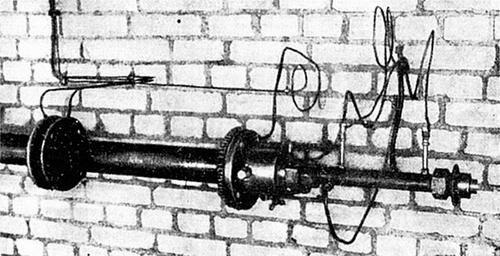 GIRD-08 Ramjet Engine
GIRD-08 Ramjet Engine
|
 R-3 Launcher
R-3 Launcher
|
Pobedonostsev's primary effort in GIRD, and in the years following, was the investigation of ramjet engines.
The first engine for project 06 was designed by I.A. Merkulov, and tested in April of 1933.
Ramjets operate only when the engine is moving at extremely high speed. To simulate supersonic flight, it was fed by air from a tank, compressed to 200 atm.
It was fueled by white phosphorus.
In 1936, he began to use a solid-fuel rocket, the R-3, to launch experimental ramjet engines to super-sonic speeds.
Pobedonostsev's brigade also experimented with sub-sonic
pulse-jet engines, similar in concept to those that powered the German V-1 cruise missile, a decade later.
The third brigade consisted of five engineers, two designers, and four mechanics:
Yu.A. Pobedonostsev
G.I. Ivanov
M.S. Kisenko
|
|
V.E. Lisichkin
V.A. Timofeev
L.E. Bryukker
|
|
I.A. Merkulov
Nikolayev
O.S. Oganesov
|
|
A.B. Ryazankin
N.N. Krasnukhin
|
The 4th Brigade
Sergey Pavlovich Korolev led the fourth brigade, which undertook the investigation of rocket-powered airplanes. Later famous for his work with ballistic missiles and space rockets, Korolev spent his early years on a series
of winged missiles, both manned and unmanned.
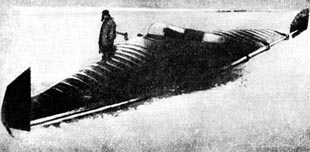 RP-1 Rocket Glider
RP-1 Rocket Glider
|
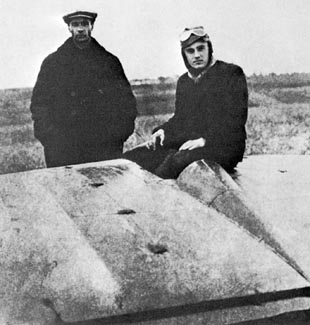 Cheranovsky and Korolev
Cheranovsky and Korolev
|
Korolev's RP-1 manned rocket-powered glider was to be powered by Tsander's OR-2 engine.
The glider was a novel flying-wing design by Boris I. Cheranovsky, the BICh-11. One was allocated to GIRD in February 1932.
For travel within the Earth's atmosphere, winged rockets using aerodynamic lift seemed advantageous to many at that time, particularly because engines were not yet very powerful.
Ultimately the RP-1 project was not completed due to difficulties with the OR-2.
Korolev worked on manned rocket planes until his arrest in 1938. These later planes included nitric acid/kerosene engines designed by Glushko, such as the ORM-65. After his arrest, Leonid Dushkin and Alexey Isaev continued this work during the war.
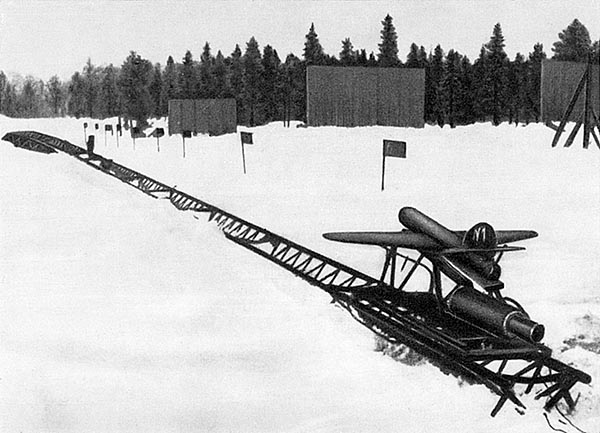
Cruise Missile on Launching Sled (1936)
Project 06 was the development of unmanned cruise missiles. The first of these crafts (06/I) was test flown in May of 1934, powered by the 09 rocket engine. This model, a modified RP-1 glider, proved to be unstable in flight.
Project 06/III, also called Object 216, was a glider powered by the OR-2 engine.
It was first tested in May of 1936.
This missile was launched with the assistance of a 750 kgf-thrust solid-fuel rocket sled on a track, as seen above. It was guided by a GPS-2 gyroscopic autopilot designed by 4th-brigade engineer S.Ya. Pivovarov.
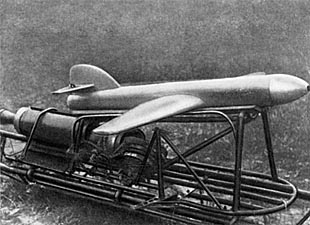 212 Cruise Missile (1939)
212 Cruise Missile (1939)
|
 GPS-3 Gyroscopic Autopilot
GPS-3 Gyroscopic Autopilot
|
Project 06/IV was Korolev's last cruise missile, also called Object 212. It was powered by Glushko's ORM-65 engine, burning nitric acid and kerosene, with a thrust of 150 kgf. It was controlled by Pivovarov's improved GPS-3 autopilot. Begun in 1936, it was not test flown until 1939, after Korolev and Glushko's arrests.
An aircraft-launched variant, Object 301, was also under development, as well as a radio-controlled guidance system.
Gyroscopic guidance systems for rockets were first employed by Goddard in 1932. Pivovarov's work on the GSP-2 around 1934-1936 was also ground-breaking and predated the similar system used in the V-1 in 1942. German rockets did not employ gyroscopic guidance until 1937. The general idea was borrowed from the gyroscopic guidance systems, long used in underwater torpedoes.
The fourth brigade consisted of six engineers, two designers and two mechanics:
S.P. Korolev
N.A. Zheleznov
A.V. Chesalov
|
|
E.S. Shchetinkov
S.A. Pivovarov
G.N. Fedotov
|
|
V.V. Gorbunov
V.V. Ivanov
B.A. Bivovarov
|
|
A.M. Durnov
|
Production Department
In addition to the four R&D brigades, Ivan Andreevich Vorobev managed the machine shop and firing stands. His department consisted of twelve mechanics, eleven turners, four metal craftsmen, three braziers, a welder, a joiner, and others:
V.P. Avdonin
P.S. Aleksandrov
A.I. Astakhov
V.M. Bezlyudov
E.I. Berg
M.V. Bochkov
F.A. Busurin
I.V. Vlasov
I.A. Vorobev
M.G. Vorobev
|
|
A.A. Vorontsov
A.I. Gavrilin
E.N. Gracheva
A.M. Durnov
A.V. Zuikov
L.A. Ikonnikov
M.P. Kapitonov
P.I. Kostyashkin
A.V. Kozpov
E.M. Matysik
|
|
Miloradov
I.M. Moiseev
A.V. Murashev
A.P. Nefedov
P.K. Nuzhdin
A.G. Okunev
N.V. Petrov
A.S. Raetsky
Rumyantsev
K.V. Semchileeva
|
|
K.K. Fedorov
B.V. Frolov
G.V. Frolov
A.N. Funtikova
P.N. Kharitonov
B.Y. Shedko
V.I. Chirkin
G.P. Bekenev
|
What Went Wrong With GIRD?
Of the many liquid-fuel rocket efforts in the 1920s and 1930s, the three most advanced and important were Robert Goddard's project in America, the Society for Space Travel (Verein für Raumschiffahrt) in Germany, and the GIRD organization in the Soviet Union.
Why did Germany ultimately produce the first fully operational liquid-fueled missile? The American and Russian efforts in the early 1930s were considerably more advanced than Germany's, so why did they fail to have as important an impact later on?
 Goddard Rocket (1931)
Goddard Rocket (1931)
|
 Goddard Rocket (1940)
Goddard Rocket (1940)
|
Robert Goddard launched the first liquid-fuel rocket in 1926. His efforts were by far the most technologically advanced. By 1932, he was experimenting with streamlined rockets with gyroscopic guidance systems. By 1940, fully modern rockets were being built, with pump-fed engines.
Unfortunately, Goddard's team was small, secretive and had almost no support from the US military.
As in Russia, the American military took a conservative view that only solid-fueled missles had potential use.
This greatly limited the historical impact of Goddard's remarkable work.
 German Mirak Rocket (1931)
German Mirak Rocket (1931)
|
 German A-3 Rocket (1937)
German A-3 Rocket (1937)
|
German civilian rocketry efforts were not nearly as advanced or well organized as the American and Russian work. The VfR rocket experiments were surprisingly primitive, with simple liquid-fuel engines and flight stabilized by long sticks.
VfR was particularly obsessed with publicity, to gain funding and support.
Nebel even proposed faking a liquid-fueled rocket demonstration, by hiding a solid-fuel engine inside.
Truly advanced rocketry in Germany began after the army took over and provided resources and professional engineers.
The first sophisticated German rocket was the A-3, tested in 1937. It represented a large leap in technology beyond its predecessors. It was streamlined and contained their first gyroscopic guidance system. The engine was pressure-fed, and it was not regeneratively cooled.
A major publication by Goddard in 1936 was probably the primary influence for the A-3 and the sudden leap forward in German technology.
The 13-ton A-4 rocket (the V-2 missile) was another quantum leap in size and sophistication. First tested in 1942, it featured a pump-fed engine that was regeneratively cooled and of unprecedented power (25 tons thrust).
GIRD made impressive progress on many fronts from 1931 to 1934. But after being merged with the Gas Dynamics Lab, to form RNII, work on liquid-fueled rockets faltered.
GDL chief, Ivan Terentevich Kleimenov, led the new combined research lab, with GIRD's Sergey Korolev acting as deputy chief.
Unfortunately, Kleimenov and most other GDL members had no interest in liquid-fueled rockets or spaceflight, and GIRD projects were soon marginalized. Korolev continued his brigade's work on cruise missiles, but Kleimenov replaced him as deputy chief with another GDL specialist.
Work on liquid-fueled rockets was further set back by Valentin Glushko, when he convinced Kleimenov to cancel all projects using liquid oxygen. This left only Glushko's work, based on the less-chemically-efficient oxidizer, nitric acid.
In 1935, Korneev and some members of his brigade, after considerable strife with Kleimenov, left and established a new design bureau: KB-7. They built the R-03 and R-06 rockets, which were tested in 1937. The R-03 was estimated to reach an altitude of 3.7 km, and the R-06 exceeded an altitude of 4 km.
While Glushko described their work as a failure, the KB-7 rockets likely held the world record for rocket altitude until the V-2 first flew in 1942!
In 1937, Stalin began his political purges, and the animosities in RNII triggered a deadly chain reaction. After opportunistic denunciations by various factions within the bureau, Kleimenov and his deputy were executed, and Korolev and Glushko were imprisoned.
Letters and historical records indicated that the purge of RNII was initiated by an ambitious and sociopathic staff member named Andrey Kostikov.
One can only speculate on what Korolev would have achieved if GIRD had received continued support after 1934.
|